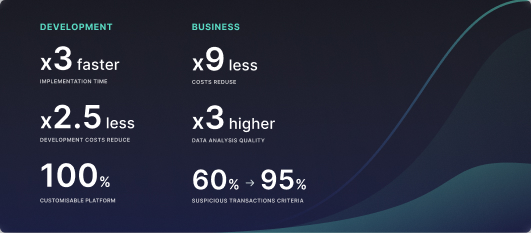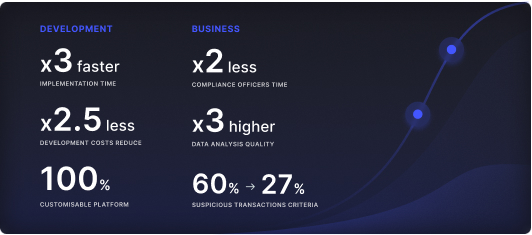Loan Origination System
3.5x faster
2.3x
100% flexible
5x lower
+73%
100%

Issue
Negative consequences:
The risk department was drowning in loan requests, failing to process them all in a timely manner. The slow loan application processing was aggravated by the legacy risk management measures (mediocre risk level calculation, suspicious action identification) that lacked automation. Above all that, the bank needed extra data storage.
- Slow credit decision-making;
Excessive manual tasks and tons of requests increased the time-to-decision and calculation costs.
- Lack of detailed client overview and banking accounts’ protection;
The legacy risk management solution offered weak client profiling and access control.
- Ineffective data management;
The Bank’s BI system required an additional database to store large amounts of client-related data and calculations.
- High IT department dependency;
The Bank’s decision-making strategy maintenance required strong programming skills. It resulted in higher IT costs and inhibited implementation.
Goal
Solution
Our team developed and implemented the credit decision platform using the ProcessMIX BRMS. At the same time, we created a database to store the results of derived calculations and decision-making strategy execution.
- Easy-to-use visual decision-making platform;
- Comprehensive risk reporting that increase risk management and detail client portfolios;
- Complete Risk Department independence from IT specialists;
- Fast, semi-automated risk calibration process done in days (instead of weeks);
- DB integration with Bank’s Oracle BI system;
Currently, we continue to collaborate with the Bank’s Risk department working on additional Business Rule management improvements.
ProcessMIX in action
- The Bank’s Oracle system transfers loan applications to ProcessMIX. This includes requested parameters, applicants’ internal and external data, and details.
- The platform initiates the first stage of analysis. ProcessMIX applies the Bank’s rules and policies and makes an application decision based on client-related data from the internal resources (banking system and database). Depending on the results of the initial analysis, the platform either declines the loan application or sends it back a request for additional info. For example, affiliated parties’ details, client’s credit history, etc.
- The second stage of analysis runs when internal resources are not sufficient for the final decision. ProcessMIX requests data from external sources (i.e. credit bureaus). If the client’s credit history or other external information regarding the client’s behavior fails to comply with the bank’s policies, the loan application is declined.
- The final stage is the credit approval or refusal of the loan, and reporting to the Bank’s Oracle BI system about the decision details.
Summary
3x faster
2.5x lower
100% customizable
We achieved the goals of our client owing to the features and functionalities of the platform. They facilitated the bank’s loan origination pipeline and reduced manual labor:
- Visual drag-and-drop interface that allows regular risk department representatives to create applications and automation tools.
- The Bank’s business users do not need to wait for the IT department to implement new decision strategy requirements.
- ProcessMIX analysis tools allowed the bank to automate its loan origination process and spot potentially risky clients.
- Pre-configured connectors to the Oracle BI system facilitated DB integration. What’s more, the platform allowed developers to create custom rules for ETL processes.
- 95% affordability calculation accuracy achieved due to ProcessMIX’s smart analysis and calculation tools.
- IDE (Integrated Development Environment). It improved our development team’s collaboration with the bank’s Risk Management Department.
- Flexible out-of-the-box architecture that gives space for further system scaling and integrations. Bank staff can add new functionalities or business rules whenever they want, according to their ProcessMIX pricing plan.
- Credit decision-making platform creation, strategy implementation, and DB integration took only several weeks.
 Visual Development
Visual Development Assignment of risk level and customer category within KYC processes during customer onboarding
Assignment of risk level and customer category within KYC processes during customer onboarding Cross-sell offer calculation for a 12MM strong client portfolio
Cross-sell offer calculation for a 12MM strong client portfolio